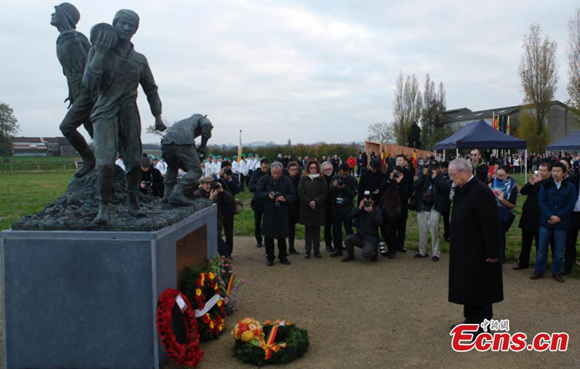
On a chilly and rainy day in the Flanders Fields, a group of young Chinese who rested in an almost forgotten part of World War I history for the past 100 years, finally got the respect and honor they deserved.
On a chilly and rainy day in the Flanders Fields, a group of young Chinese who rested in an almost forgotten part of World War I history for the past 100 years, finally got the respect and honor they deserved.
In the village of Busseboom of Poperinge city, west Belgium, where 13 Chinese laborers were killed in a German bombardment on Nov. 15, 1917, a new bronze statue standing 3 meters was erected on Wednesday.
The statue depicts three laborers doing the most common jobs for them in the battlefields -- carrying shells, digging trenches and evacuating wounded soldiers.
Chinese, Belgian and Flemish anthems were sung for the victims at an inauguration ceremony attended by officials, diplomats, journalists and local residents.
Wreaths were laid in front of the statue by mayor of Poperinge Christof Dejaegher, Chinese Ambassador to Belgium Qu Xing and British Ambassador Alison Rose, among other Chinese and Belgian dignitaries.
Hundreds of veterans wearing poppy flower brooches, villagers, overseas Chinese and schoolchildren also braved the rain to witness the historic moment.
"We think it is indispensable, for our generation who enjoy peace, to build a monument to commemorate them, about 20,000 Chinese laborers-as-soldiers who devoted their lives to come to a place they had never been, and to help a people they had never met," said the Chinese ambassador in an emotional speech to the crowd.
In the last two years of the WWI, some 140,000 Chinese laborers came to Europe, providing logistic services to the Allied Forces, who at that time were suffering severe manpower shortage.
A total of 20,000 of these laborers never made it back to their motherland. Some died of illness and the tough working conditions, the others from attacks like the one in Poperinge.
"Although they were not directly involved in the battles, quite often they worked very closely to the front-line, sometimes only 50 meters from enemies," said Qu. "We can also imagine the number of wounded soldiers who due their lives to a prompt evacuation from the battlefields."
Dejaegher told Xinhua that the idea for the statue came from Belgian scholar Philip Vanhaelemeersch who translated into Dutch a memoir of a Chinese student who worked as an interpreter for the laborers during WWI, and revived the widely unknown history for the locals.
"We find it important because this part of WWI history was almost forgotten. It's a pity. The Chinese lived here, worked here, fought for our freedom. We want to commemorate their contributions to our victory," said the mayor.
He also welcomed Chinese visitors to his city to see the statue and trace the path of those who made the ultimate sacrifice for peace.
Although their stories had remained for a long time unknown to the public, their work did not go unappreciated.
In 1998, French President Jacques Chiraq wrote to the descendents of these laborers-soldiers, "We will never forget those brave men coming all the away from China to join us, body and soul, in a cruel war to defend our territory, value and freedom."
The British ambassador, whose country along with France were the main recruiters of Chinese laborers during WWI, said it was a pity that the laborers did not receive the honor they deserved at the end of the war, and thanked the Chinese embassy and the city of Poperinge for building the monument.
Rose said that in every school trip to the old battlefields funded by the British government, schoolchildren were required to visit the cemeteries of the Chinese laborers.
"Britain will never forget them," she added.
The statue took Chinese-Belgian sculptor Yan Shufen four months to create, who stressed that she felt honored as an ethnic Chinese to undertake the project.
Next to the new statue, another statue by Belgian sculptor Jo Bocklandt was erected a few years ago, also depicting the figure of a Chinese laborer.
A series of commemoration events kicked off earlier this year in the city to mark the centenary of the deaths of the 13 Chinese laborers, including an exhibition featuring rare photos of the laborers' lives in Belgium.


















































